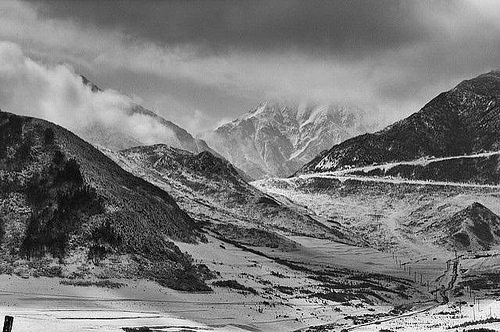
PLOS—The Tibetan people have inherited variants of five different genes that help them live at high altitudes, with one gene originating in the extinct human subspecies, the Denisovans. Hao Hu and Chad Huff of the University of Texas, Houston, and colleagues report these findings in a new study published April 27th, 2017 in PLOS Genetics.
The people of Tibet have survived on an extremely high and arid plateau for thousands of years, due to their amazing natural ability to withstand low levels of oxygen, extreme cold, exposure to UV light and very limited food sources. Researchers sequenced the whole genomes of 27 Tibetans and searched for advantageous genes. The analysis identified two genes already known to be involved in adaptation to high altitude, EPAS1 and EGLN1, as well as two genes related to low oxygen levels, PTGIS and KCTD12. They also picked out a variant of VDR, which plays a role in vitamin D metabolism and may help compensate for vitamin D deficiency, which commonly affects Tibetan nomads. The Tibetan variant of the EPAS1 gene originally came from the archaic Denisovan people, but the researchers found no other genes related to high altitude with Denisovan roots. Further analysis showed that Han Chinese and Tibetan subpopulations split as early as 44 to 58 thousand years ago, but that gene flow between the groups continued until approximately 9 thousand years ago.
The study represents a comprehensive analysis of the demographic history of the Tibetan population and its adaptations to the challenges of living at high altitudes. The results also provide a rich genomic resource of the Tibetan population, which will aid future genetic studies.
______________________________________
The Tibetan Plateau in Qinghai. Credit: DaiLuo, Flickr, CC BY
__________________________________________________
Tatum Simonson adds: “The comprehensive analysis of whole-genome sequence data from Tibetans provides valuable insights into the genetic factors underlying this population’s unique history and adaptive physiology at high altitude. This study provides further context for analyses of other permanent high-altitude populations, who exhibit characteristics distinct from Tibetans despite similar chronic stresses, as well as lowland populations, in whom hypoxia-related challenges, such those inherent to cardiopulmonary disease or sleep apnea, elicit a wide-range of unique physiological responses. Future research efforts will focus on identifying the interplay between various adaptive versus non-adaptive genetic pathways and environmental factors (e.g., hypoxia, diet, cold, UV) in these informative populations to reveal the biological underpinnings of individualized physiological responses.”
Article Source: PLOS ONE news release
__________________________________________________
*Hu H, Petousi N, Glusman G, Yu Y, Bohlender R, Tashi T, et al. (2017) Evolutionary history of Tibetans inferred from whole-genome sequencing. PLoS Genet 13(4): e1006675. doi:10.1371/journal.pgen.1006675
__________________________________________________
Subscribe to Popular Archaeology Premium. Available on all laptops and mobile devices, and still the industry’s best value at only $9.00 annually.
___________________________________________
Travel and learn with Far Horizons.
____________________________________________
This richly illustrated issue includes the following stories: Recent findings shedding new light on the whereabouts of the remains of Philip of Macedon, father of Alexander the Great; how an archaeologist-sculptor is bringing bones of the dead back to life; archaeologists uncovering town life at the dawn of civilization; an exclusive interview with internationally acclaimed archaeologist James M. Adovasio about what makes the Meadowcroft Rockshelter prominent in the ongoing search for the first Americans; what archaeologists are finding at the site of the ancient city of Gath, the home town of the biblical Philistine giant, Goliath; and how scientists are redrawing the picture of human evolution in Europe. Find it on Amazon.com.








